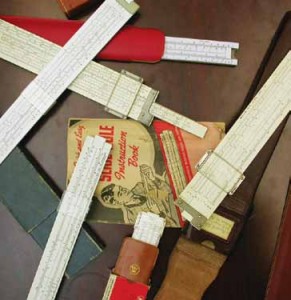 When Paul Flynn ’48, MS ’50, started his engineering education at Johns Hopkins in July 1944, he came equipped with a slide rule-and little else. “We didn’t have computers,” says the Baltimore native. “As for simple calculations, we did those in our head.”
When Paul Flynn ’48, MS ’50, started his engineering education at Johns Hopkins in July 1944, he came equipped with a slide rule-and little else. “We didn’t have computers,” says the Baltimore native. “As for simple calculations, we did those in our head.”
Flynn started at Homewood near the end of WorldWar II, when academic calendars ran year-round to prepare men as quickly as possible for the armed forces. Student life was Spartan. Students’ tools were minimal.
Today, the typical Homewood student is wired for success. But for some, there remains a fondness for putting pencil to paper and calculating equations in their heads. “I have a whole drawer of sliderules,” says the Whiting School’s vice dean for education Ed Scheinerman, who trots them out occasionally as a curiosity for undergrads. “I was right on the cusp. In high school, I used a slide rule for my chemistry class. The next year, in physics, I had a calculator.”
“I have a whole drawer of slide rules.” —Ed Scheinerman, vice dean for education, who occasionally shares his collection as a curiosity for undergrads.
For Nancy Kelley, mother of freshman engineering student Eric Kelley, the “must-have” tool of her collegiate years was quite a bit heavier. “I received a Royal electric typewriter (complete with hard carrying case) as a high school graduation gift,” she recalls. “It weighed probably 30 pounds.” When her son arrived on campus for move-in day this fall, he brought a laptop, cell phone, and Xbox 360 gaming system. His roommate contributed the requisite flat screen television.
Stephen Kaminski ’97 remembers arriving with a graphing calculator and desktop computer, which he used to type lab reports and to do his Fortran homework. “I didn’t use the Internet once while I was at Hopkins,” Kaminski recalls. And phone calls? They were made from the landline in his dorm. When he applied to law school, he typed all 13 of his applications-one a day for nearly two weeks.
There’s no doubt that today’s Hopkins students are wired, or rather, wireless. Consider their computers: “A desktop?” asks MouhamedAlkaysi, a resident assistant and civil engineering major. “I don’t think I’ve ever seen anyone with a desktop.” His fellow RA Christopher Pastrana confirms: “I don’t think I’ve ever met a person without a laptop.”
Today’s essentials: LCD televisions, with screens as big as 42 inches; tiny iPods that pack thousands of songs; standard cell phones; and smart phones such as the iPhone, BlackBerry, Android. But such phones aren’t used for calling. “It’s all texting,” says Alkaysi.
In the classroom, Scheinerman says, technology provides enormous opportunity. There’s no way to attack today’s complicated engineering problems without high-powered computing power.
There may be a downside, though-the loss of intrinsic understanding that comes from visualizing and physically solving problems with pen and pencil. “Today you plug equations into a computer and these graphs appear automatically-beautifully,” Scheinerman says. “The graphs are better than what you can do by hand. But what you gain in speed, you may lose in intuition.”
Still, he has no intention of turning back. “Sure you can design an airplane using only a slide rule,” Scheinerman says. “But you can design a much better one, a much more fuel-efficient one, with extensive computational modeling.”




